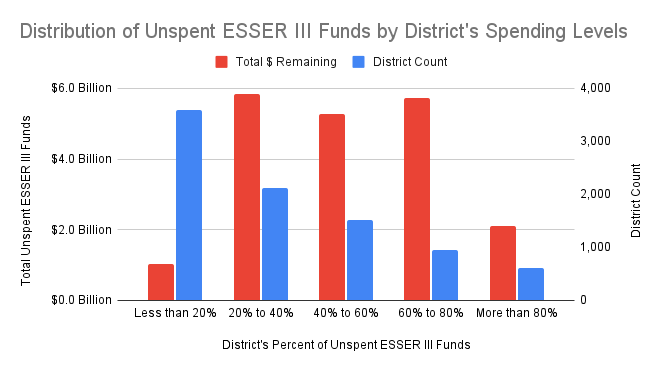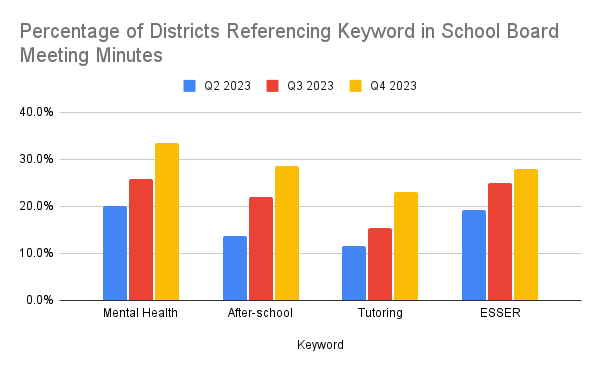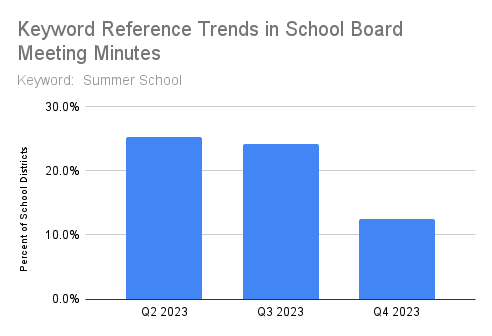1. Under current ESSER III guidelines funds must be obligated by September 30th, 2024, and disbursed by January 28th, 2025. In the Fall, the U.S. Department of Education announced that states and districts can apply for 14-month extensions to spend funds.
The upcoming April to June period is the 2024-25 budget planning period for most K-12 districts and represents the endgame of federal stimulus spending passed during Covid-19. Given that, we want to precisely analyze the distribution of districts with available ESSER III funding. For this analysis we examined district-level reporting from just over 8,800 districts 27 states that have reported since November 30th.
In the chart below we break the districts down by quintile of percent of ESSER III remaining, and show the number of districts and the cumulative amount of unspent dollars in each group. A few observations about the distribution. First, the extremes that have the least available funding between them:
- The largest group, at just over 3,500 districts, has less than 20% of their ESSER III funding available. The cumulative amount remaining from that group is $1 billion.
- The smallest cohort consists of 621 districts that report having over 80% of ESSER III funds remaining, or just over $2 billion. This group resembles a barbell - just 27 large districts report just over $1 billion remaining while the other $1 billion is in the remaining 500+ districts. Given how far we are into the spending cycle, we can't help but be skeptical of the quality of reporting for this particular group of districts.
In the middle three quintiles, districts with a track record of reporting spending make up the bulk of unspent funds and present the most interesting opportunity for 2024/25:
- Just over 2,000 districts have between 20% and 40% of unspent funding totaling $5.8 billion.
- Just over 1,500 districts have between 40% and 60% of unspent funding totaling $5.3 billion.
- Just over 950 districts have between 60% and 80% of unspent funding totaling $5.7 billion.
Here is the distribution. Note blue is the district count, and red is the dollars remaining:

Even taking lag times in reporting into account, these figures indicate that billions of dollars of ESSER III spending will be committed and spent during the 2024-25 budget cycle. The funds available are concentrated in about 50% of the districts nationwide, and the commitment to spend will be front-loaded in the 2024-25 fiscal year due to the deadlines involved.
2. Burbio's School Board Meeting Tracker covers school board meetings for just under 2,000 school districts each month, representing over 50% of the K-12 school population. We introduced the service at the beginning of Q2 2023 and have been expanding since.
Given the history we have accumulated, we are in a position to map some trends over time. This week we highlight mentions of five broadly cited subjects - Mental Health, Afterschool, Tutoring, ESSER, and Summer School. A few notes:
- For Q2, our coverage set included just over 40% of K-12 students, before expanding to over 50% for Q3 and Q4.
- The chart below documents the percentage of districts that mentioned the term at least once in the quarter.
- For mental health, we also searched for behavioral health. For tutoring, afterschool, and summer school, we searched for slight variations i.e. "tutors" "extended day" or "summer program." For ESSER we searched for that term exactly.
Our first chart shows four of the terms whose mentions have all increased over the course of 2023:

It would seem there should be seasonality to certain subjects given the schedule of the academic year. We see this with summer school, whose frequency was highest in Q2 - right before summer - and lowest in the Fall:

3. Burbio State-Level Funding Tracker compiles state-level funding sources and provides clients a sortable dashboard and an email alert system that allows for instant updates. In addition to grants available to K-12 districts from all state sources, we include Federal grants where states can tailor the criteria.
A recent example is the "Bipartisan Safer Communities Act Stronger Connections Grant Program" known more generally as "Stronger Connections." The program allows for states to tailor the grants to high-need LEAs covering a range of uses across school safety, student supports, behavioral interventions, and family engagement. Grants were awarded over the last year and many states have listed the winning districts. Among the examples nationwide:
- New Hampshire's grant is very focused on physical security. “Applications must focus on at least one of these three priority areas for funding (including) Access control activities (that) involve actively engaging/controlling the flow of people into the school facility . . . Emergency alerting activities . . . (and) Surveillance activities (that) involve physical security capabilities . . ."
- New Jersey's description outlines a variety of mental health and community engagement initiatives with no mention of physical security.
- North Carolina's grant focuses on three priority areas including "Strategies that meet each student’s social, emotional, physical, and mental well-being needs . . . Engaging students, families, educators, staff, and community organizations . . . (and) Designing and implementing policies and practices that advance equity."
- California's program allows for the entire spectrum of uses from mental health services, to programs for at-risk youth, to the purchase of security equipment.
- Arizona's program was "focused on providing resources to ‘High-Need LEAs’ to hire, train and support effective School Safety Officers (SSOs) for their school(s)."